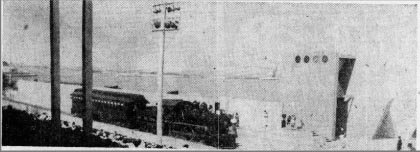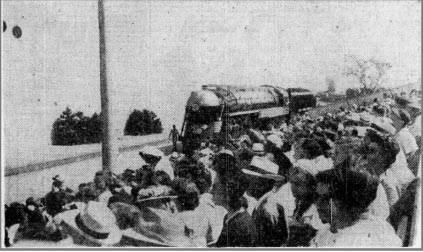
Engine Number 999, Running On Chicago Line, Published 4 September 1948   All your life you have heard of "engine, engine, 999, running on Chicago line." Well, you can see it at the Chicago Fair. For it and many other ancient and wonderful locomotives have been brought to the Windy City for the Railway Fair. All you have to do is to take in the pageant, which lasts one hour and 15 minutes, and you'll see everything from the Indian sending smoke signals before the white man got there to the smashing crescendo of the Burlington's sleek, white, two mile a minute streamliner come throbbing onto the stage. I shouldn't say stage, because it is natural ground of Chicago and the backdrop is the eye-filling panorama of green-blue Lake Michigan. If you see the show through, you'll even hear them sing Alouette when the French missionaries arrive, and to the tune of The British Grenadiers, Stevenson's "Rocket" rolls by at the interesting speed of eight miles an hour. All Like Trains The
railroads of Chicago have discovered that we are all small boys and
girls when it comes to trains, as 16,000,000 paid admissions, up till
recently, testified. So, they decided to wrap up the history of United
States with that of the railroad. So first come those early .
experiments, and then The Best Friend of Charleston, with its first
American built locomotive, but with coaches still like stage coaches.There is a poignancy too, when tall, gaunt Lincoln makes that famous speech as he leaves Springfield, Illinois, to become the president, and then even more moving is the funeral train, crawling by, bearing Lincoln's assassinated body, the little coaches , decorated with black and purple. Ths scene shifts to the west. There is the thrilling Pony Express, where the riders change horses on the run, then the stage coach, the inevitable holdup, and of course, right ofl the cob, the American cavalry arrives to chase the maurauders. Then comes the Harvey girls, with their black dresses and white aprons, and so too comes the Santa Fe train and its hungry customers. Hardly have the passengers settlied down to enjoy the Harvey girls when out come the girls from the Golden Nugget Cafe and begin doing the can can. The men are no longer interested in food. Driving Last Spike Of
great interest to many was the driving of the last spike between the
Chinese-built Central Pacific, from the Pacific Ocean eastwards, and
the Union Pacific, from the Missouri Pacific westward. So a sister
engine to the bonnet-stacked Jupiter of the old Central Pacific, and
No. 119 of the Union Pacific, now owned by the Burlington railroad,
meet at Promontory Point, Utah, where the golden spike is driven in
1869 to join east and west. (Our own Lord Strathcona used just an
ordinary spike.)Incidentally, the most melancholy picture I have seen in many a year was in the press a year or so ago when the meeting at Promontory Point was done in reverse. At that place, the U.P. tore up its tracks. Again there were the engines, again there were the scenes, only this time the spike came out. When you run your movies backward, everything is in reverse. Promontory Point in reverse was a sad, sad moment for old railroaders like myself. For a camera fan like me, the stuff came at me so quickly I could hardly get all the engines in my Zeiss camera. Unhappily for me I ran out of kodachrome, and missed some of those color-rich little engines of long ago, delightfully reincarnated for this occasion. All of us recall the rhyme about engine, engine 999, because it ran on the Chicago line. What fewer people realize is that this little engine ran 112 miles an hour on the New York Central way back in 1893. We don't even do that well yet around here. I had seen NYC 999 at the Century of Progress in 1933, but was glad to greet an old friend again. Not All Trains But
it was not all trains. I think the finest collection of fast-step ping,
high-stepping horses I have seen in a long time was there, as we had
everything from the old coach to the surrey with the fringe on top.
Lillian Russell, greatest beauty of her day, arrived in a smart
carriage to be met by Diamond Jim Brady. Then these people moved oft
the scene, and we got the first bicycles, and later, to the tune of My
Merry Oldsmobile, the first cars. So the pageant swung into the 20th century, and we had such dull and serviceable items as the Chicago and Eastern Illinois ten wheeler, and others that came after. Finally, in a grand finale, out came big 5426, a fancied up behemoth that handles the NYC's Mercury. As she rolled majestically down the iron, casting a shadow the size of a cloud, there roared in on the far track a slick, white Burlington Diesel. It was a smashing, thrilling finale. It was a far cry from smoke signals by the Indians to smoke signals by the Mercury, but America had made it. |
![]()